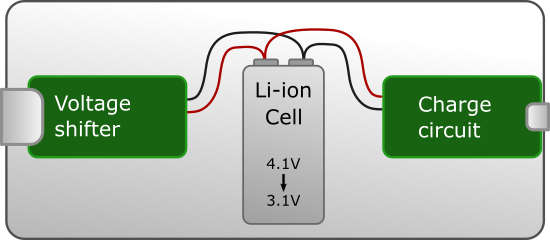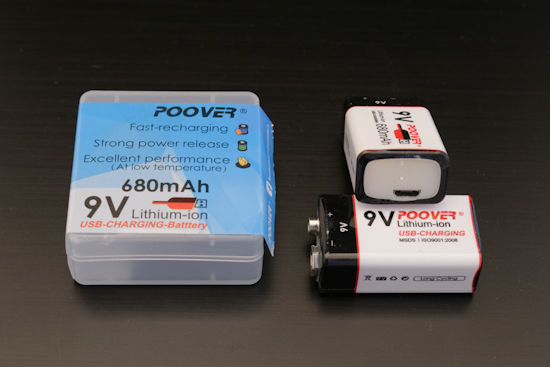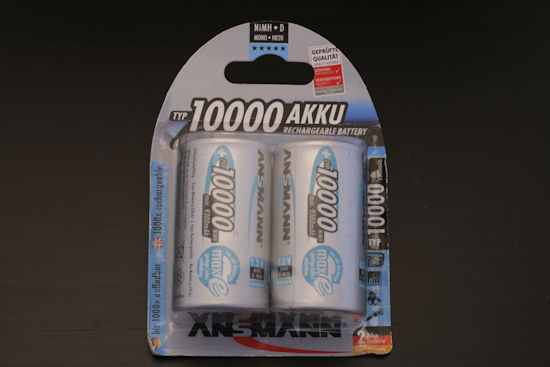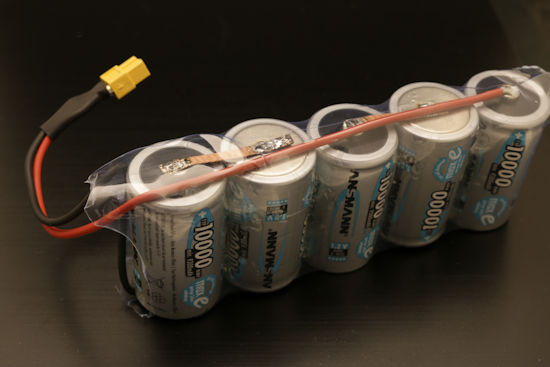![]() One of the complex and recurring questions that we get is the use of rechargeable batteries to power autonomous measuring systems. Using a backup battery for smart phone provides an easy solution, but adequate models for this kind of use are not that frequent. Today, we present two alternatives that you can use in specific cases.
One of the complex and recurring questions that we get is the use of rechargeable batteries to power autonomous measuring systems. Using a backup battery for smart phone provides an easy solution, but adequate models for this kind of use are not that frequent. Today, we present two alternatives that you can use in specific cases.
The 3 issues with backup batteries
Backup batteries for smart phone are usually made of a Lithium-Ion cell, to which is added some electronics to charge on the input, and some electronics to shift the output voltage level up to 5V

Simplified diagram of the content of a USB backup battery
The first issue is that the voltage shifter electronics consumes some power, even when no device is connected. Therefore, there is usually a circuit which disconnects it as soon as load goes under a threshold for a given time period, to avoid auto-discharge. If you use this kind of system for a low consumption sensor system, the battery is thus going to disconnect the output electronics as soon a the sensor system goes into energy saving mode, and it can never be turned on again.
The second issue may occur depending of the design of the backup battery: some models cannot be charged during use. This prevents usage with unpredictable energy source such as solar panels, as well as any use as backup power source to compensate for a power failure, as they cannot provide any current when they are connected to a power supply.
The third issue is linked to transportation. If the measuring system must travel on a plane, or any other transportation means where fire is not acceptable, it must conform to very strict regulations concerning Lithium battery transportation. Depending on the case, this may disqualify the system for the application.
First alternative: Two cell Li-ion batteries
One solution to avoid the first issue consists in using a battery based not on one but on two Li-ion cells, which does not include voltage level enhancement and therefore doesn't have a shut down mechanism. It's the case of the small "9V" batteries by POOVER:

POOVER rechargeable battery
While these batteries have the traditional shape of 9V batteries, they are in fact Li-ion batteries. The voltage of two Li-ion cells is not exactly the same of an alkaline 9V battery, but given that the voltage of a standard battery decreases as it is used, devices designed for 9V alkaline batteries necessarily work with lower voltages, hence the idea of using the same shape.
To use them with a Yoctopuce sensor system, you must naturally add a component which lowers the voltage to a maximum of 5V without consuming anything: the Mini-Battery-Supervisor. We tested it with a set of modules which go into deep sleep to save energy (a YoctoHub-Wireless-g with two Yocto-Altimeter), and as planned, the battery stays active even during the deep sleep and enables the system to wake up.
The second advantage of this product is that the battery output stays active when the battery is charging. Charge is made using the USB micro-B connector located at the bottom of the battery.
The only issue with these small batteries is that they are ... small. For a system with radio transmission and a few sensors, we can't get more than 180 minutes of activity, that is a week of autonomy with a one-minute wake-up period every hour. But they are also very interesting as backup power supply for a system which must always stay active even in case of power failure. These batteries allow you to measure and transmit data even during a long power failure period.
Second alternative: High capacity NiMH batteries
There are now on the market NiMH batteries in the D format (the largest cylinder-shaped batteries) with a nominal capacity of 10'000mAh.

10'000mAh NiMH battery
By serially combining five of those batteries, we obtain a system which compares well in terms of capacity to a Li-ion battery, to which you only need to add a Mini-Battery-Supervisor to stabilize the voltage to 5V in order to power Yoctopuce modules.

6V 10Ah NiMH battery
It's quite easy to implement this pack.
- Start by aligning the batteries of a flat surface and glue them together with hot glue to keep them in position,
- With a soldering iron, put a tin drop at each end of the batteries. Initially, it may look like the tin doesn't stick to the battery surface, but as soon as the surface is warm enough, the drop stays without any trouble.
- You may use for example desoldering braid to connect the batteries serially. The tin drop that you have previously deposited enters the braid and ensures a good contact. Be careful when you connect the batteries to not make a loop (short) !
- At each end of the battery pack, solder electric wires, a red (+) one and a black (-) one.
- Cover everything with a large heat-shrinkable insulating sheath, or if you don't have any with resistant adhesive tape.
Beware, don't forget that such a battery pack can store enough energy to heat an electric wire to the point that it can create a fire hazard in case of short, so be careful.
We wanted to check whether these batteries could indeed honor the announced capacity, as they represent a Lithium-free alternative, not as dangerous for transport. Here are the consumption and discharge graph of our little test system, still made of a Mini-Battery-Supervisor, a YoctoHub-Wireless-g, and two Yocto-Altimeter:

Discharge graph of our battery pack
During this test, we have been able to use 7'500mAh, althouth the battery was not fully loaded at the beginning. So it is a perfectly usable solution for a system which must remain autonomous for a long period of time, as the 36 hours of continuous use become 90 days of intermittent use at the rate of 1 minute per hour. Another test at full charge showed 10 hours more of continuous use.
You must however note that charging 5 high capacity NiMH cells in series requires a sophisticated charging circuit, and can hardly be done without a stable power source. This solution is therefore most appropriate for systems working solely on a battery.
Conclusion
These two alternatives to USB backup batteries enable you to deal with some scenarios. But we certainly hope to provide you one day with a more universal solution for the continuous power supply of autonomous systems...


